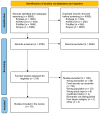A Scoping Review of Nutritional Biomarkers Associated with Food Security
- PMID: 37630766
- PMCID: PMC10459650
- DOI: 10.3390/nu15163576
A Scoping Review of Nutritional Biomarkers Associated with Food Security
Abstract
Food insecurity affects more than 40 million individuals in the United States and is linked to negative health outcomes due, in part, to poor dietary quality. Despite the emergence of metabolomics as a modality to objectively characterize nutritional biomarkers, it is unclear whether food security is associated with any biomarkers of dietary quality. This scoping review aims to summarize studies that examined associations between nutritional biomarkers and food security, as well as studies that investigated metabolomic differences between people with and without food insecurity. PubMed, Embase, Scopus, and AGRICOLA were searched through August 2022 for studies describing food insecurity and metabolic markers in blood, urine, plasma, hair, or nails. The 78 studies included consisted of targeted assays quantifying lipids, dietary nutrients, heavy metals, and environmental xenobiotics as biochemical features associated with food insecurity. Among those biomarkers which were quantified in at least five studies, none showed a consistent association with food insecurity. Although three biomarkers of dietary quality have been assessed between food-insecure versus food-secure populations, no studies have utilized untargeted metabolomics to characterize patterns of small molecules that distinguish between these two populations. Further studies are needed to characterize the dietary quality profiles of individuals with and without food insecurity.
Keywords: biomarkers of nutritional status; dietary assessment methodologies; food security; metabolomics; nutrition; nutrition security; review.
Conflict of interest statement
Gary Wu receives research funding from Nestle, Intercept Pharmaceuticals, and Abbvie, and is an advisory board member for Danone and BioCodex. Ariana Chao reports grants from Eli Lilly and Company, the National Institutes of Health, and WW International, Inc., and has consulted for Eli Lilly and Company outside the submitted work. Lev Krasnovsky, Aidan Crowley, Fawaz Naeem, and Lucy Wang have no disclosures to report.
Figures


References
-
- Cafiero C., Viviani S., Nord M. Food security measurement in a global context: The food insecurity experience scale. Measurement. 2018;116:146–152. doi: 10.1016/j.measurement.2017.10.065. - DOI
Publication types
MeSH terms
Substances
LinkOut - more resources
Full Text Sources

